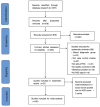Polysomnographic nighttime features of Restless Legs Syndrome: A systematic review and meta-analysis
- PMID: 36090852
- PMCID: PMC9452633
- DOI: 10.3389/fneur.2022.961136
Polysomnographic nighttime features of Restless Legs Syndrome: A systematic review and meta-analysis
Abstract
Background: Restless Legs Syndrome (RLS) is a common sleep disorder. Polysomnographic (PSG) studies have been used to explore the night sleep characteristics of RLS, but their relationship with RLS has not been fully analyzed and researched.
Methods: We searched the Cochrane Library electronic literature, PubMed, and EMBASE databases to identify research literature comparing the differences in polysomnography between patients with RLS and healthy controls (HCs).
Results: This review identified 26 studies for meta-analysis. Our research found that the rapid eye movement sleep (REM)%, sleep efficiency (SE)%, total sleep time (TST) min, and N2 were significantly decreased in patients with RLS compared with HCs, while sleep latency (SL) min, stage shifts (SS), awakenings number (AWN), wake time after sleep onset (WASO) min, N1%, rapid eye movement sleep latency (REML), and arousal index (AI) were significantly increased. Additionally, there was no significant difference among N3%, slow wave sleep (SWS)%, and apnea-hypopnea index (AHI).
Conclusion: Our findings demonstrated that architecture and sleep continuity had been disturbed in patients with RLS, which further illustrates the changes in sleep structure in patients with RLS. In addition, further attention to the underlying pathophysiological mechanisms of RLS and its association with neurodegenerative diseases is needed in future studies.
Keywords: Polysomnographic; Restless Legs Syndrome; meta-analysis; pathophysiology; sleep.
Copyright © 2022 Geng, Yang, Zhang, Xu and Zhang.
Conflict of interest statement
The authors declare that the research was conducted in the absence of any commercial or financial relationships that could be construed as a potential conflict of interest.
Figures
Similar articles
-
Polysomnographic features of idiopathic restless legs syndrome: a systematic review and meta-analysis of 13 sleep parameters and 23 leg movement parameters.J Clin Sleep Med. 2022 Nov 1;18(11):2561-2575. doi: 10.5664/jcsm.10160. J Clin Sleep Med. 2022. PMID: 35903949 Free PMC article.
-
Trazodone changed the polysomnographic sleep architecture in insomnia disorder: a systematic review and meta-analysis.Sci Rep. 2022 Aug 24;12(1):14453. doi: 10.1038/s41598-022-18776-7. Sci Rep. 2022. PMID: 36002579 Free PMC article.
-
Polysomnographic nighttime features of narcolepsy: A systematic review and meta-analysis.Sleep Med Rev. 2021 Aug;58:101488. doi: 10.1016/j.smrv.2021.101488. Epub 2021 Apr 5. Sleep Med Rev. 2021. PMID: 33934047
-
Sertraline and rapid eye movement sleep without atonia: an 8-week, open-label study of depressed patients.Prog Neuropsychopharmacol Biol Psychiatry. 2013 Dec 2;47:85-92. doi: 10.1016/j.pnpbp.2013.08.010. Epub 2013 Aug 29. Prog Neuropsychopharmacol Biol Psychiatry. 2013. PMID: 23994660 Clinical Trial.
-
Impaired slow oscillation, sleep spindle, and slow oscillation-spindle coordination in patients with idiopathic restless legs syndrome.Sleep Med. 2020 Feb;66:139-147. doi: 10.1016/j.sleep.2019.09.021. Epub 2019 Oct 31. Sleep Med. 2020. PMID: 31877505
Cited by
-
Sex-based disparities in dopamine agonist response in patients with restless legs syndrome.J Sleep Res. 2025 Apr;34(2):e14311. doi: 10.1111/jsr.14311. Epub 2024 Aug 19. J Sleep Res. 2025. PMID: 39160111 Free PMC article.
-
Large muscle group movements during sleep in restless leg syndrome: neurophysiological and clinical implications.Sleep. 2024 Jul 11;47(7):zsae113. doi: 10.1093/sleep/zsae113. Sleep. 2024. PMID: 38761118 Free PMC article.
-
Prevalence of restless leg syndrome and associated comorbidities in a sub-saharan African general population: results from the Benin Society and Sleep (BeSAS) study.Sleep Breath. 2025 Mar 25;29(2):138. doi: 10.1007/s11325-025-03307-1. Sleep Breath. 2025. PMID: 40131581
References
Publication types
LinkOut - more resources
Full Text Sources


